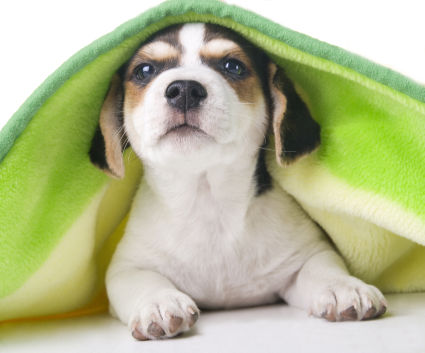Anyone who has ever spent time with a sleeping dog knows that it is not an all unusual to see the puppy twitch in his or her sleep.
In addition to twitching, there are usually sound effects that go along with the movement of the dog’s muscles. When combined, the twitching and noises tend to make one think that the dog is dreaming.
Research has proven that dogs do dream when sleeping. In fact, experts on canine behavior say that dogs do experience different phases of sleep just as human beings do. The big difference between dogs and people is the length of their sleep cycles. Humans sleep cycles are longer than those of humans.
Canine sleep cycles include a period of non-rapid eye movement (NREM), rapid eye movement (REM) and short wave sleep (SWS). When in the short wave sleep mode, dogs tend to start to breathe deeply. This mode of sleep leads to the rapid eye movement stage in which dogs dream – just as humans – causing the muscles to twitch in anticipation of whatever the dream inspires. In short, experts think that dogs act out their dreams and this is the reason that the dog begins to twitch, yelp or growl.
Research has also shown that puppies and old dogs tend to dream more than middle aged and adult dogs so you can expect to see more twitching in the very young and old canines.
The cliché “leave sleeping dogs lie” could actually result from waking a sleeping dog while it is experiencing rapid eye movement. Just as with humans, dogs can be grouchy if deprived or awakened during the rapid eye movement period. It is best to leave dreaming dogs sleep.
It can be difficult to tell the difference between a dog that is experiencing a rapid eye movement sleep cycle and one that is having a seizure. This confusion happens frequently with first-time dog owners.
There is a way to tell the difference between a dog that is seizing and a canine that is experiencing rapid eye movement. Seizures tend to come on very quickly, causing the dog’s body to become stiff. Muscles frequently lock up and a seizing dog will tremble more heavily than a sleeping dog.
Seizing dogs lose consciousness and pant heavily while sleeping dogs may jerk suddenly and return quickly to a relaxed state of sleep.
If you call your dog’s name when he or she is experiencing twitching motions, you will be able to tell the difference between a sleep and a seizure. A sleeping dog will immediately wake up. A seizing dog will not be able to respond.
As previously noted, try not to wake your dog while he or she is dreaming. If you have to do it a time or two to learn the difference between normal sleep and a seizure, that is okay. However, one you realize the difference, allow the dog to relax and get an uninterrupted sleep.






0 Komentar